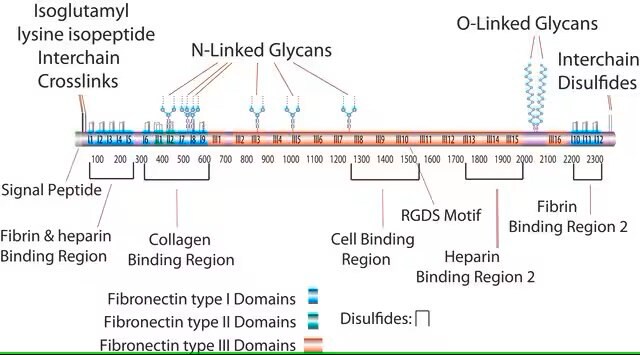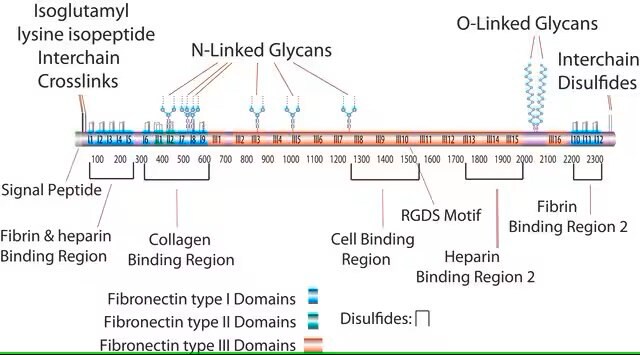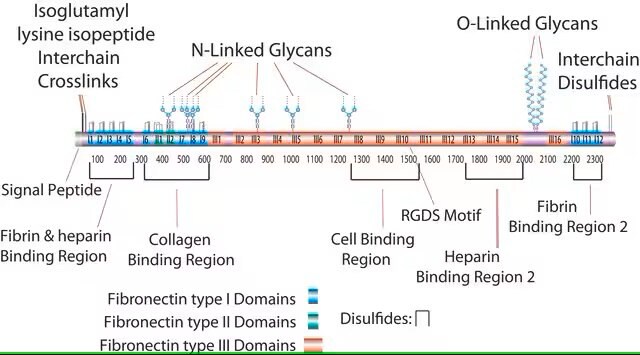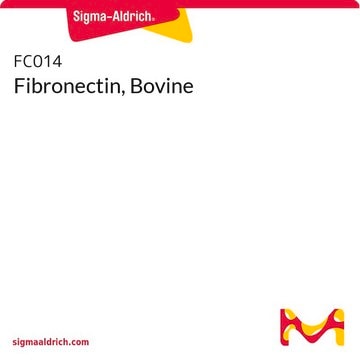The concentration of the 0.1% solution can be found in the Certificate of Analysis. To calculate micrograms per square centimeter, consider the volume used and the surface area of the well.
F0895
Human Fibronectin
from human plasma, liquid, 1 mg/mL, suitable for cell culture
Sinonimo/i:
Fibronectina
Scegli un formato
Scegli un formato
About This Item
Prodotti consigliati
Nome del prodotto
FIBRONECTINA DA PLASMA UMANO, liquid, 0.1% (Solution), BioReagent, suitable for cell culture
Origine biologica
human plasma
Livello qualitativo
Sterilità
sterile
Nome Commerciale
BioReagent
Stato
liquid
Confezionamento
pkg of 1 mg
pkg of 2 mg
pkg of 5 mg
Concentrazione
0.1% (Solution)
tecniche
cell culture | mammalian: suitable
Copertura della superficie
1‑5 μg/cm2
Solubilità
saline: 0.05 M (Tris-buffered)
N° accesso UniProt
Specificità del legame
Peptide Source: Collagen
Condizioni di spedizione
wet ice
Temperatura di conservazione
2-8°C
Informazioni sul gene
human ... FN1(2335)
Cerchi prodotti simili? Visita Guida al confronto tra prodotti
Descrizione generale
FN esiste come proteina dimerica che presenta due legami disolfuro a ponte all′estremità C-terminale.[2] All′interno della struttura della fibronectina, in prossimità di entrambe le estremità N- e C-terminali delle catene peptidiche i domini presentano un′organizzazione spaziale compatta.[3] È stato inoltre osservato come, nonostante abbia origine da un singolo gene, negli esseri umani siano state identificate fino a 20 distinte varianti di questo gene.[2]
Applicazioni
Azioni biochim/fisiol
Caratteristiche e vantaggi
- Glicoproteina adesiva
- Da plasma umano
- Copertura superficiale raccomandata di 1-5 μg/cm2
Nota sulla preparazione
Per rivestire superfici di colture la fibronectina si deve diluire in soluzione salina bilanciata e sterile e applicarne un volume minimo. La superficie dovrebbe essere essiccata all′aria per 45 minuti a temperatura ambiente e può essere conservata per 2-4 settimane a 2-8 °C
Risultati analitici
Note legali
Esclusione di responsabilità
Prodotti correlati
Codice della classe di stoccaggio
12 - Non Combustible Liquids
Classe di pericolosità dell'acqua (WGK)
WGK 1
Punto d’infiammabilità (°F)
Not applicable
Punto d’infiammabilità (°C)
Not applicable
Scegli una delle versioni più recenti:
Certificati d'analisi (COA)
Non trovi la versione di tuo interesse?
Se hai bisogno di una versione specifica, puoi cercare il certificato tramite il numero di lotto.
Possiedi già questo prodotto?
I documenti relativi ai prodotti acquistati recentemente sono disponibili nell’Archivio dei documenti.
I clienti hanno visto anche
Articoli
Fibronectin (FN) plays crucial roles in extracellular matrix fibril assembly and cellular interactions.
Lung organoids are valuable 3D models for human lung development and respiratory diseases. The 3dGRO™ differentiation protocol generates organoids from human iPSCs in 4 steps.
The extracellular matrix (ECM) and its attachment factor components are discussed in this article in relation to their function in structural biology and their availability for in vitro applications.
The extracellular matrix (ECM) is secreted by cells and surrounds them in tissues.
Protocolli
Dilute fibronectin for cell attachment, varying per cell type. Coating protocol, products, and FAQs provided.
-
How many µg/cm² would the coating concentration be if I applied a coating with a 0.1% concentration using the F0895 product?
1 answer-
Helpful?
-
-
What is the recommended storage duration for Fibronectin (F0895) at 4°C, -20°C, and -80°C? How long can a diluted solution of 10ug/mL in PBS be stored at 4°C? Is it possible to reuse the Fibronectin solution to coat culture ware surfaces multiple times?
1 answer-
The recommended storage duration for Fibronectin (F0895) is up to 1 year at 4°C. There has been no testing done on its stability after storage at -80°C or -20°C. A diluted solution of 10ug/mL in PBS can be stored at 4°C for 2-4 weeks. However, the solution cannot be reused to coat culture ware surfaces multiple times; the recommended process involves coating surfaces with a minimal volume, allowing them to air dry for 45 minutes at room temperature, and then storing the cultureware at 4°C for 2-4 weeks.
Helpful?
-
-
What is the recommended dilution rate for coating the culture surface with F0895-1MG Fibronectin as per the preparation instructions?
1 answer-
The recommended dilution rate for coating the culture surface with F0895-1MG Fibronectin, as per the preparation instructions, is to start with a concentration in the range of 1 - 5 ug/cm^2. For a 96-well plate well with a surface area of about 0.34 cm^2, approximately 2 ul of F0895 further diluted in saline with a total volume of around 50 ul would be sufficient to cover the bottom of the well.
Helpful?
-
-
How should I store and handle Product F0895, Fibronectin from human plasma?
1 answer-
Recommended storage of this material is 2-8 °C. Vortexing, excessive agitation, repeated freezing and thawing of reconstituted fibronectin are not recommended.
Helpful?
-
-
What is the Department of Transportation shipping information for this product?
1 answer-
Transportation information can be found in Section 14 of the product's (M)SDS.To access the shipping information for this material, use the link on the product detail page for the product.
Helpful?
-
-
What is the solvent for Product F0895, Fibronectin from human plasma?
1 answer-
This material is solubilized in a 0.05 M Tris-buffered saline, pH 7.5.
Helpful?
-
-
How much Product F0895, Fibronectin from human plasma, do I use for my application?
1 answer-
Recommended for use as a cell culture substratum at 1-5 μg/cm2 or 0.5-50 μg/mL. Optimal concentration depends on cell type as well as the application or research objectives.
Helpful?
-
-
Is Product F0895, Fibronectin from human plasma, sterile?
1 answer-
Fibronectin 0.1% solution is a sterile product. It is tested for sterility. The sterility test results can be found on the lot-specific certificate of analysis.
Helpful?
-
Active Filters
Il team dei nostri ricercatori vanta grande esperienza in tutte le aree della ricerca quali Life Science, scienza dei materiali, sintesi chimica, cromatografia, discipline analitiche, ecc..
Contatta l'Assistenza Tecnica.










